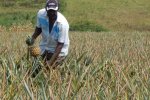Sue Auma
Author

Spend the highest percentage of your farming proceeds expanding your scale of production and you’ll never go wrong.
This is the top secret of John Olielo, a renowned pineapple farmer in Homa Bay County. In 1992, Olielo resigned from his job in Nairobi and went back to his home in Kaura village, Kochia East Location in Homa Bay County to try his luck in agriculture. The now 57-year-old man ventured into production of peanuts, cassava, and pineapples.
Two years later, he had made a paltry Sh8,000 from peanuts and Sh200,000 from pineapples, a tidy sum of money back then. From the proceeds, he settled on pineapple propagation. At that time, many farmers in the area had begun deserting pineapples due to loses. Olielo appeared to many as a fool who did not know what he was getting into by purchasing pineapple suckers for planting from them.
“Since my life had entirely been based in Nairobi, people from this area sold their pineapple suckers to me. Many thought I did not know what I was getting into. Some were overheard saying they were selling me the suckers knowing I would make huge losses, but did not care as I was giving them money,” Olielo said.
Being a risk taker, Olielo bought the suckers anyway. The risk paid off. By 2002, Olielo had become a prosperous pineapple farmer, with his fruits attracting people from major towns in Nyanza region such as Kisii, Kisumu, and Migori. His prosperity motivated other residents, most of whom had abandoned pineapple production, to venture back into the trade. The entire Kaura village was turned into a pineapple jungle. But with the high returns came problems. With so much money from their farms, most pineapple farmers turned to a life of luxury. “Many people thought pineapple production was not meaningful to them anymore because they had got the money they needed.
This made a number of farmers live a life of luxuries which could not allow them to continue growing the crop,” said George Onyach, another farmer. Today, the farmers who had abandoned pineapple production view it as a difficult venture which requires a lot of money to undertake because the cost of purchasing suckers has escalated rapidly.
“Pineapple farming has become so lucrative that obtaining suckers is near impossible for low-income earners wishing to venture into it. Currently, we have only three pineapple producers in this village,” says Onyach.
But Olielo remained steadfast, instead of increasing his production by plowing back proceeds from his pineapples back to the farm. He, however, says he would have also fallen into the same trap had he not listened to his friends who asked him to plow his proceeds back to the farm to scale up his production. “I decided to concentrate on pineapple production by spending three-quarters of my returns to producing more pineapples,” he says. His strategy worked almost immediately. Olielo doubled his production scale. Today, he grows pineapples in 10 acres of land located in various parts of the village. The main challenge afflicting Olielo is the high frequency of weeding pineapple requires.
“This crop takes two years to mature. It requires a lot of weeding, especially during the rainy seasons. I usually have hectic moments during the rainy seasons because by the time you finish weeding a plantation, the part from which you started also requires weeding too,” he says.
But pineapples do not require fertilizer and are not affected by pests and diseases like other crops. Pineapples require a fine ground. As such, harrowing is done twice before the suckers are planted. Olielo says the experience has made him a better pineapple farmer.
One important lesson he has learned through the years is that the crop does not require rotational cultivation. But he has learned that planting in the same piece of land consequently reduces the yields. “After harvesting pineapple from a given piece of land, I have to acquire land through leasing because it cannot yield well when repeated subsequently on the same piece of land,” he added.
Today, Olielo has 210,000 pineapple plants in all his plantations acquired through leasing. Each plant can yield four or more fruits in their lifespan.
Harvesting is done in intervals, according to when the crops were planted in various plantations. A harvesting season lasts for three months. “I plant the crop at various intervals to avoid getting losses by being overwhelmed when they get ripe at the same time,” he said. Olielo sells his fruits to large scale businessmen from Nairobi, Kisumu, Kisii, and Eldoret at between Sh50 and Sh70 each. He also sells to local traders who supply various hotels in the county. Goreti Atieno, a trader based at Olare trading center in Homa Bay sub county says Olielo’s pineapples have created employment for many people who sell them in various forms. “He is the chief producer of the fruits we sell. This has provided income not only at Olare but other parts of this county,” said Atieno.
He says thanks to the crop, he has educated his children up to college level. He urges the locals to resume pineapple farming to eradicate poverty in the area.
This feature was first published in the Smart Harvest Magazine.
Article source - Biznakenya
Last edited:
